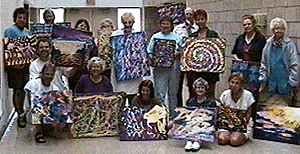| Top | Getting Started | Yellow
| Washing Yellow | Red, Blue |
|
|
|
|
Students from Wayne County Community College create Micropointillist work in less than three hours in their first attempt. |
A SHORT HISTORY
I invented this medium in 1977 while I was doing my Masters
of Fine Arts at Wayne State University. At the time, I was
experimenting with cross pollinating some of the more delicious
attributes of intaglio with lithography.
Within the intaglio process, one can build up tonality and depth
with a process called 'Aquatint'. The closest lithography could
come to this build-up of tone was by the use of photographic
dot-matrix which was too stiff for my approach to art. Another
method was with a 'conte' stain, which was too hard to control
and tended to fill in or disappear during printing. I found that
by using an atomizer to blow successive layers of liquid
asphaltum onto a litho plate, interspersed with areas 'blocked'
with gum arabic, I was able to create and control tonalities of
ink. It was then a simple step of producing the three color
plates with this method, thus creating images with primary and
secondary colors. In the last months of my degree, it struck me
that I would be unable to afford the equipment to do either
intaglio or lithography, so I decided to see if the process could
be adjusted so it could be applied to a regular surface.
It could.
After leaving the university, my good friend and compatriot Lowell Boileau and I continued the
development of the process. It was he who coined the name
'Micropointillism' and realized that by substituting silk-screen
block in the place of gum arabic, one could avoid the brittle
cracking that tended to occur during the painting process. Over
the years I have taught many people to use this medium, and
eventually realized the need to produce an easy to follow manual.
So here it is:
